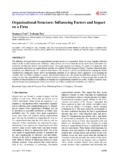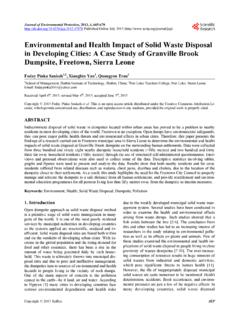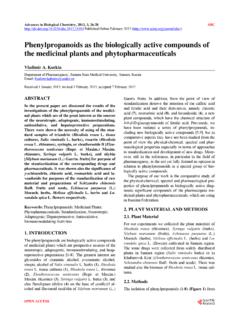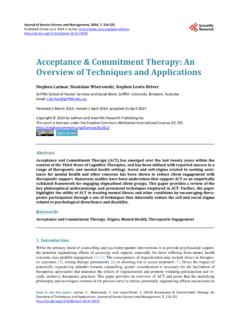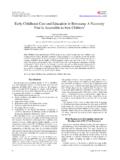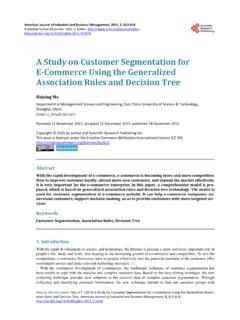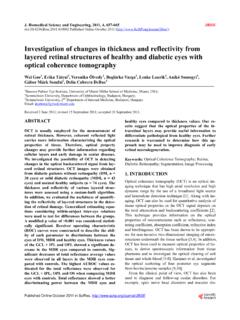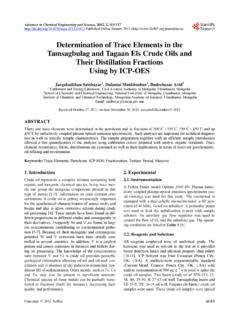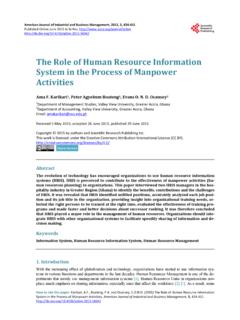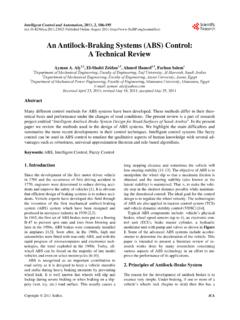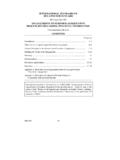Transcription of A Literature Review on the Definition of Corruption and ...
1 Open Journal of Social Sciences, 2016, 4, 171-177 Published Online June 2016 in SciRes. How to cite this paper: Liu, (2016) A Literature Review on the Definition of Corruption and Factors Affecting the Risk of Corruption . Open Journal of Social Sciences, 4, 171-177. A Literature Review on the Definition of Corruption and Factors Affecting the Risk of Corruption Xizi Liu School of Government, Beijing Normal University, Beijing, China Received 24 May 2016; accepted 25 June 2016; published 28 June 2016 Copyright 2016 by author and Scientific Research Publishing Inc. This work is licensed under the Creative Commons Attribution International License (CC BY). Abstract To choose a set of definitions on Corruption and summarize the quantitative measures of corrup-tion, this article gives some comments on a wealth of global indicators of Corruption .
2 Based on the academic research, the factors of Corruption could be mapped in three levels: macro, meso and micro. In the past, most literatures pay attention to the macro factors to study the relationship between Corruption , development, culture and politics. In the meso-level, internal system con-struction is the most important factors on Corruption . More and more scholars tend to use the real raw data rather than the perception of data to study the Corruption of a certain country or region. Micro factors research on Corruption will become increasingly popular in the future. Keywords Corruption , Factors, Macro, Meso, Micro 1. Introduction The increasingly anti- Corruption efforts of the Chinese Communist Party and the government make Chinese scholars pay much attention to the Corruption . More than 49 thousands people have been punished for an eight- point regulation in 2015, these violators were found to have been involved in 37 thousands cases during the campaign.
3 In fact, the problem of Corruption is always with China since the founding of the People s Republic. More generally, the problem can trace back to ancientry coming out with the country. In past research, scholars have made abundant achievements about Corruption , especially in the Definition and related clinical factors on Corruption . There are various definitions of Corruption in theory field. The most widely used Definition is Corruption is X. Z. Liu 172 taken to be the abuse of public office for private benefit , which has pointed out the nuclear connotation of cor-ruption. According to different studying objects and purposes, the precise Definition and measurement could dis-tinguish between different issues. This article gives a Review of the factors affecting the risk of Corruption from the macro, meso and micro levels. Each factor alone affects the risk of Corruption and the influence will not just flow one way, hence the interaction among all factors was very complex.
4 I hope the Literature Review would pro-vide worthy reference and be helpful for the following academician. 2. What Is Corruption ? Definition of Corruption Rousseau once pointed out that the legitimacy of the national public power comes from the people. The gov-ernment is the executor of the sovereign. Its power comes from the people s trust. When the use of public power deviate from the original track, being abused, Corruption problems arise. It accords with the Definition of the abuse of public office for private benefit . This Definition is also the most widely used by foreign scholars on the concept of corruption1. The research of Corruption as a specific concept of public administration in China began in the 1980s and 1990s. Wang Huning and Huang Bai Lian defines Corruption as non-public use of public power (abuse and unfair exchange).
5 Most scholars believe that Corruption is the only government official acts of abuse of power [1]. He (2003) thinks from this concept that Corruption includes the subject of Corruption , motivation (purpose), means, the way and the consequences and puts the negative Corruption into the scope of Corruption . He particularly points out that a lot of Corruption is hiding under the cloak of acts of abuse of power with viola-tion of the established codes of ethics [2]. At present Chinese and foreign academic circles have not formed a unified Definition of the Corruption . It is usually defined as the Corruption of public officials in the state organs use power in the hands for bribery, cor-ruption, extortion, fraud and other acts. But this term includes many aspects of economy, politics, culture, mo-rality, law and so on. In recent years, the extension of Corruption has continued to expand.
6 The main body of Corruption is no longer confined to the national institution. More subjects are included. For example academic Corruption refers to the Corruption in universities and research institutions. The forms of Corruption include not only public officials personal gain behavior but also interest exchange process, such as nepotism, nonfeasance and disposal of public resources [3]. Bussell (2015) pointed out that there are many ways to define Corruption in detail. But no Definition can be applied to all research purposes [4]. Therefore, first of all the diversity of the Corruption s content should be recognized. From the research intent, the appropriate concept of Corruption and measurement methods are se-lected. This approach is more adapted to the current study for the purpose to give a Definition of Corruption is to do better in scholarly studies.
7 Determination of Corruption The transnational research of Corruption usually adopts the Corruption index provided by the international data-base, such as CPI of Transparency International, WBES of World Bank Institute and Corruption Index of Intel-ligence Unit. Most of the index comes from a survey of people, businesses, or experts [5]. Most of these compo-site index, reflecting the various aspects of Corruption , describe the general situation of Corruption from the overall and provide a great convenience for the evaluation of Corruption and empirical research [6]. But the per-ception data reflects the ideas of data source on Corruption and cannot guarantee that there is a link between the subjective indicators and the actual level of Corruption . At the same time, due to the existence of the same index in different years of the composition and weight adjustment, part of the index s the time longitudinal compara-bility is poor, so there is a certain misleading in the time series analysis.
8 For the foregoing reasons, some scholars choose practice cases instead of international database in quantita-tive research. In the study of the relationship between economic and political Corruption , Ruske (2015) used in-dividual Corruption data of US Congress members provided by CREW [7]. Many scholars use the objective data to study the Corruption problem between regions and achieved great fruits in China. On the research of govern-ment size and Corruption of market and local regions, Zhou and Tao (2009) use the number of Corruption cases 1 World Bank: Corruption is the abuse of public power for private benefit. Similar to Corruption is the abuse of public power for private gain. This Definition has been used by many scholars on the concept of Corruption See, , Olken (2007), Bardhan (2006), Jain (2001), and Rose-Ackerman (2011).
9 X. Z. Liu 173 of officials of the state organs as the index to measure the degree of Corruption of the state organs [8]. Li and Zhang (2014) use the proportion of the number of local officials (people/million) accounted the number of cor-ruption cases [9]. Gong, Wu (2012), Qiao (2013) take the method of direct collection of Corruption cases to conduct empirical research. These scholars attempts provide a powerful reference for the more comprehensive and more objective study of Corruption in China [10] [11]. There is no unified view regarding the determination of Corruption achieved yet. In the Literature of recent years, scholars usually use a number of corrupt data base provided by agencies to measure Corruption level in order to be more accurately. At the same time, more and more scholars tend to start from the objective index, the real case, a specific country and a case research of a region, because variable of each country is doubtful in ho-rizontal comparison in the international Corruption research.
10 3. Research Progress on the Related Factors of Corruption The research of related factors of Corruption is the most important aspect in the Corruption study. From the ma-cro level, the Corruption level of a country to a certain extent should determine by the country s economic, po-litical and cultural level. At the same time, Corruption has effect on these three parties. From the medium view, system construction and execution of the decentralization degree between the national agencies, recruitment, appointment, compensation and punishment not only affect the bud of Corruption , but also has a significant im-pact on the spread of Corruption . From the microscopic level, even when the individual is in the same or similar external environment or under the same system, there may be significant differences in the risk of Corruption due to the influence of individual gender, education, values and other factors.
